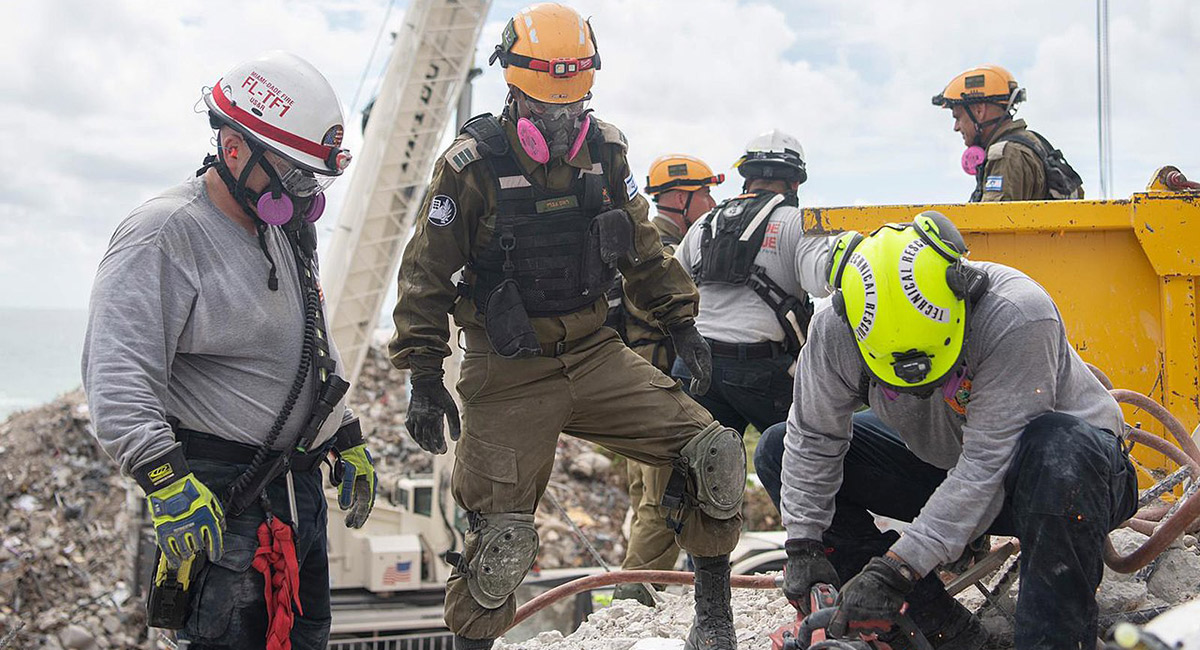In the middle of the night on June 24, 2021, two major sections of Champlain Towers, a 12-story residential condominium in Surfside, FL, just north of Miami, suddenly collapsed. Waking up to the news was surreal, evoking memories of other building disasters from the last 30 years.
On July 4, the remaining part of the building, which had become unstable, was demolished to provide safer working conditions for rescuers. As of July 7, the death toll was 46, with 11 injured and 103 unaccounted for.
Building collapses seemingly out-of-the-blue are rare, but they have happened before. Often, the causes can be linked to the degradation of building materials by natural weathering, or age. Sometimes they may be due to the underlying ground shifting or subsiding. It is well known that land can subside and compact under the weight of large buildings, or if moisture evacuates from beneath the surface.
Some experts say it might be years before the immediate cause of this building failure is known. That did not stop others from immediately speculating that climate change may be the reason for the building collapse, specifically pointing to global or local rises in sea level.
Some, like E&ENews.net, National Geographic, and Time, were cautious, reporting that climate change and sea-level rise driven by it might have played a role while adding that the true cause remains unknown. Yet they treated it as an opportunity to warn afresh of the dangers of rising sea levels. U.S. Energy Secretary Jennifer Granholm quickly connected the event with climate change. Though she stopped short of direct blame, she immediately faced accusations of using the tragedy for political purposes.
Others were less reticent. In an article headlined “Sea level rise due to climate change eyed as contributing factor in Miami-area building collapse,” Yahoo News Senior Editor David Knowles wrote of “the possibility that sea level rise caused by climate change may have contributed to the disaster.” USA Today was less cautious, headlining “Rising seas are dangerous. Florida collapse is a tragic wake-up call.”
Attributing tragic events to climate change is almost a default response these days. Additionally, a few scientists and politicians repeatedly claim that global sea level may rise 20 feet or more by the end of 2100. Such sea-level rise could be the result of extreme changes in climate projected to occur by 2100, due to emissions of greenhouse gasses by human activity.
Such extreme climate change projections are meant to frighten the public into supporting more and more regulation of the economy. But they lack solid scientific basis.
Let us set the record straight, first by distinguishing global from local sea-level changes. Global sea level has risen and fallen in the past due to thermal expansion or contraction as the global ocean warms or cools. These changes can also occur due to growth or melt of land-based ice. Local sea level changes can be due to land compaction or rebound as weight is added to or removed from it, e.g., as glaciers grow or shrink. Sedimentation also makes local sea-level change differ from global.
The Intergovernmental Panel on Climate Change (IPCC) Assessment Reports have tracked global sea level changes over the years. The Fifth Assessment Report was issued in 2013–2014; the next is due in 2022. In the interim, the IPCC released a Special Report on the Ocean and Cryosphere in a Changing Climate. This reported global sea-level rise of 1.4 millimeters annually for most of the 20th century—about six inches in total. It also reported that the rate for the decade leading up to the report was almost 2.5 times faster, or 14 inches per century. However, it is difficult to compare the mean change of a quantity over the course of a century with short-term changes over the course of a decade because the long-term rate includes short-term faster and slower rates. It follows that it is fallacious to project a more rapid long-term future rate based on a short-term recent rate.
Further, this same report offers no support for claims that global sea level could rise 20 feet or more in this century. Instead, it projects about 17 inches under the lower-end climate change scenarios, and about 33 inches under the highest-end scenarios. The latter could be problematic for coastal areas, but the IPCC has less confidence in the higher end scenarios. Further, peer review journal articles have shown that climate models can’t reproduce past temperatures without ad hoc adjustments, entailing that they don’t properly misrepresent the climate system, and those that project high-end warming are plagued by theory bias and other errors. Meanwhile, observed changes in climate are at the lowest end of the model-projected changes in climate.
Historically, sea-level changes have been faster than today. Researchers believe they have not been constant, and may have been very little during some centuries, but as much as 7–15 feet in others. If sea levels rose at a constant rate from the end of the last ice age to today, that increase would be about one to two feet per century, depending on when the end of the ice age was identified.
Sea level itself has always differed over time as well. For example, during the last interglacial period (about 120,000 years ago), sea level could have been 20 to 30 feet higher than today. During the last ice age, when vast amounts of water were bound up in glaciers covering large parts of the Northern Hemisphere, it was likely about 390 feet lower than today.
Sea level rise may be faster now than a century ago, but it has been faster before, and we have the means and technology to adapt to it now.









